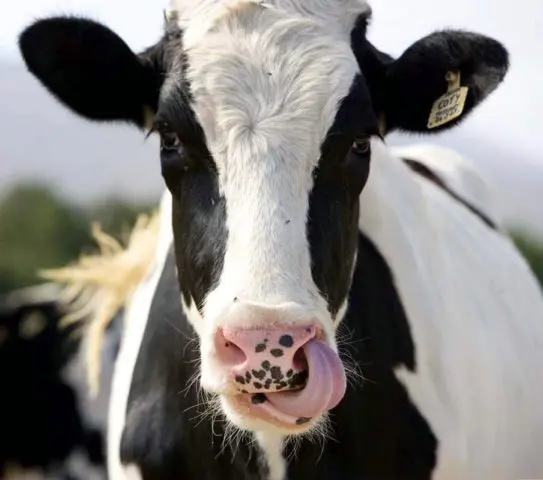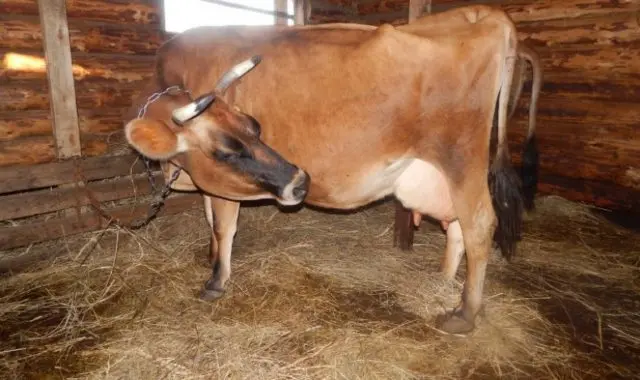Contents
It is not always possible to milk a cow after calving. This process directly depends on the characteristics of the birth of calves. Like most mammals, cows may have some difficulty in obtaining and producing milk. Lactation in an animal can be long, but it is necessary to follow all the rules of competent milking.

What is cow milking
Milking cows is a set of measures aimed at creating feed resources, organizing competent feeding, observing all milking technologies, creating the necessary conditions for keeping and care, which lead to the manifestation of milk productivity in an animal.
The rate of appearance of milk depends on properly organized milking, the quality of nutrients supplied with food to the cow’s body. It is important to provide her with enhanced nutrition immediately after calving. Without this, animals will not be able to feed and fully show their productive qualities. The secretion of milk affects all organs of vital activity: blood circulation, respiration, digestion, and the nervous system. Therefore, care must be taken to improve the health of the animal constantly. Only then can you achieve good milk productivity, high-quality milk yield. As a rule, abundant milk yields are obtained from cows with a strong physique, fairly developed internal organs. These properties are laid down from the moment of birth and are maintained throughout life. That is why it is necessary to take care of good lactation, high-quality milk yield from the first days of the animal’s life.
How many hours should a cow be milked after calving?
Usually, the first milking of a cow after calving should be done no later than 2 hours after the appearance of the calf. In small private farms, milking is done by hand, and on large farms, with the help of milking machines. With the first milking, colostrum is obtained – a certain secret of the mammary gland of mammals, which contains substances involved in the laying of the immune system.
The calf will help to properly milk the cow after calving. This will solve several important problems at once:
- for a cow, milking with a calf is less painful than with a milking machine or by hand;
- the calf receives colostrum, which is vital for him;
- a calving individual behaves much calmer during milking with a newborn calf, she passes stress faster;
- the calf develops a sucking reflex.

Colostrum is milked for another 3-4 days after calving. It is necessary during this period to let the newborn to the cow. A week or two after calving, the calf must be isolated from the mother.
Как раздаивать корову после отела
Milking of a cow must begin after calving, but for 2 weeks the milk goes exclusively to feed the newborn calf. After that, the udder and the entire body of the cow gradually returns to its normal physiological state.
Since during calving the animal loses a lot of fluid, in order to restore the water balance, you need to drink the individual with two buckets of lightly salted water. This liquid will quench your thirst and stimulate your appetite. After that, some hay is given to the cow and her back is wiped for a quick contraction of the uterus and a successful discharge of the placenta. After a couple of hours, you can start milking.
You can feed the animal after calving with hay, fresh grass, you must definitely give a mixture with concentrates. After 3 days, without reducing the volume of concentrates, succulent feed is added to the diet. You can not overfeed the animal the first days after calving. Because of this, appetite can be significantly reduced, intestinal pathologies often occur, and the udder becomes inflamed. As a result, a significant reduction in milk yield. Only after a couple of weeks, provided that the cow has fully recovered from calving, can you return to your normal diet. During this period, nutrition will depend on the body weight of the animal, the quantity and quality (fat content) of milk produced, as well as the time of year that calving occurred.
When calculating the feeding rate for a calving individual, you need to take as a basis the milk yield that you would like to receive. For unproductive animals, the amount of milk received does not depend on the quality and quantity of complementary foods. For high-yielding, productive cows, the feeding ration is compiled in such a way as to get 3-5 liters more milk. For animals with average milk production – to get 3 liters of product more than the actual milk yield. It will be necessary to increase the feeding ration while the milk yield is growing. When milk yields are reduced, advanced feeding is completed.
Concentrates and root crops give the highest growth in milk yield. If a cow constantly increases milk yield with increased feeding, then it is necessary to introduce succulent feed into the diet without reducing the amount of hay. It is important to diversify the feeding ration of a calving cow: with uniform feeding, the appetite decreases, and milk yields fall accordingly. Usually the diet is changed every 2 weeks.
How many times to milk a cow after calving
Milking a cow after calving is a special, complex process. After calving, most animals have a slight swelling of the udder. This is a natural state and usually goes away after a while. To facilitate her well-being and prevent inflammation of the udder, it is necessary to milk as often as possible, 5-6 times a day. If milking is carried out with the help of the machine, then it is possible to milk 3 times, but after each time, after 1-2 hours, milk also with the machine.
As udder swelling subsides, the number of milking sessions can be reduced. First you need to switch to 4 times a day, then reduce milkings to 3 times. If the farmer is dealing with high-yielding animals, you should stop at 3 times milking with an interval of 8 hours.
Should a cow be milked after the second calving?
The milking of calving cows is carried out during the first 100 days from the moment the production of mature milk begins. This time is the highest. Feeding, care and distribution will depend on how much time has passed since the first calving and on the physiological state after it. If at the first calving there were no pathologies, the udder is not overstressed, then you can not make dietary restrictions and freely feed silage, hay and haylage. At the same time, concentrates and root crops should be limited, they should be added to the diet gradually.

When can you drink milk after a cow calves?
Milk is a high-quality, protein product that is indispensable for many people, and even more so for children. However, few people know how long after the appearance of the calf, it is ready for use.
As you know, after calving during milking, colostrum is produced, which is necessary for the body of the calf. It can be eaten by people, but it has a specific taste and smell, because of this, not everyone likes colostrum. It is actively secreted for another 8-10 days, then the cow produces milk that is known to everyone. From this period, it can be safely eaten.
Tips for milking cows
It is customary to pay special attention to the calving and milking of cows. The productivity of cows depends on these processes. The disintegration process includes:
- compliance with the rules of maintenance and care;
- compliance with sanitary standards;
- correct milking;
- regular massage of the mammary glands immediately before milking;
- advance type of feeding.

It is recommended to adhere to certain intervals between feeding and milking. The animal quickly gets used to the regime and will have time to allocate the required amount of milk by the set milking time.
The lactation period is divided into several main stages:
- colostrum – lasts up to 8 days;
- milking stage (main) – up to 100 days;
- average – 100 days;
- the final one is also about 100 days.
After colostrum, the cow produces transitional milk. Then the quality of milk is restored, it becomes mature.
After calving, after about 10-14 days, when the udder of the animal returns to normal and the colostrum is replaced by mature milk, you can start a new feeding system. This is a period of intensive milking of the cow. She is already ready to eat more food for the subsequent production of additional volumes of milk. Usually increase the amount of food consumed by several feed units. When the cow stops responding to supplements, a gradual reduction in concentrates is started.
The main tips on the technology of milking cows are the competent conduct of advance feeding:
- experts recommend giving 50% of concentrates in a chilled state in order to increase the process of assimilation of feed;
- it is desirable that in large farms the technologist keeps records of milking cows and periodically conducts control milkings;
- feeding should be carried out regardless of the system of keeping cattle;
- milking is considered to be successfully carried out if already on the 40th day after calving the productivity of the animal increased by 1,2 times compared with the milk yield on the 14th day.
After a successful milking, the main task is to maintain the level of productivity for as long as possible.
Conclusion
It is necessary to milk a cow after calving with some experience and knowledge in this area, since the lactation process is cyclical and depends on the appearance of a calf. In order for cows to lactate consistently and last as long as possible, the farmer needs to properly prepare for this milking period. Any, even a healthy and young animal, requires support and care from the owner.










Kikawaida ndama anatakiwa kupewa maziwa kwa kipindi cha miezi minhapi?